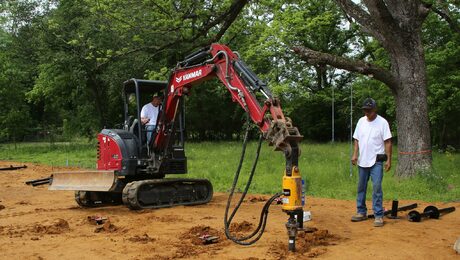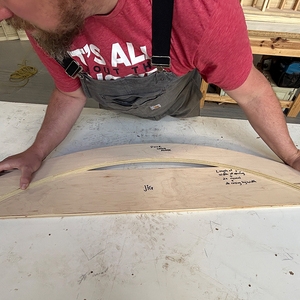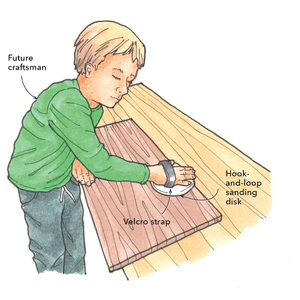Been reading recent thread on plywood Vs. OSB, I now know that I should be using Advantech subfloor. So, off the cuff, someone tell me what you think of this floor system and how it should be improved, if at all.
UFP Open Joist 2000 floor trusses (and don’t tell me to use TJI’s ’cause I won’t) 11-7/8″ depth, spanning maximum 15′-4″, 24″ O.C. Advantech subfloor, 3/4″ thickness (well, 23/32″), glued and screwed.
Options I have available to me (in order of cost):
1. Increase depth of floor trusses to 14″
2. Increase O.C. spacing to 19.2″ or 16″
3. Increase subfloor thickness to 7/8″ or 1-1/8″.
What would you do, or is the initially proposed system adequate?
FYI, this system will be used under tile and hardwood (solid unfinished), and will have staple-up radiant tubing underneath.
Edited 8/20/2004 7:54 am ET by Jon



















Replies
I don't see any point in increasing the depth of the floor trusses. An 11 7/8" depth spanning 15'-4" should be fine. It's well within my comfort zone, and I'm pretty conservative on floors.
The only thing that bothers me at all is the tile. I've always been told that floor members HAD to be 16" O.C. under tile. Dont really know why, it's just what I was taught. I'd strongly recommend talking to your tile supplier about it. They may not warranty their installation if the framing is 24" O.C.
I did a thread a while back on Floor Vibration that might interest you.
I hate coffee. It keeps me awake at work.
Well, I tend to agree with you about the tile. 16" o.c. really isn't that big of a deal to do, just somewhat more of an expense. I think what I may do , is put joists 16" o.c. under the kitchen and master bathroom anyway, which is where the tile will be, and where all the weight will be anyway. The rest will remain 24" o.c.
Thanks.
Tile has little tolerance to deflection...the stiffer the floor the better off you'll be. Plywood has greater deflection when forced to span 24" when compared to 12" or 16". Deflection is also present in the floor joists (or trusses). The two ways to reduce joist deflection are to reduce the load to the joist by reducing their O.C. spacing or going with a joist that has a greater section modulus and moment of inertia. The latter can be accomplished by going with a deeper joist. The tile manufacturer should be able to give you a maximum allowable deflection for the tile. It's then up to you to make sure that the joists and plywood meet or excede these requirements.
I agree with what thew others have said. It's all about bounce under tile. Generally we use a backer in addition to the Advantech. Different tile installers like different materials so I always ask them what they want. Most tile gets damaged from something dropped on it. It would have to be a minimum design floor or worse to cause deflective breakage.
We don't often think about acoustics when we build but for some customers it can be quite important. Nothing worse than a floor that acts as a sound board, especially in an audio room.
You have to be careful with stapled up radiant heat. Any nails or screws in the bays will spell disaster. Flooring can only be adequately nailed on the joists and you had better snap them out accurately. Some flooring (hardwood) products are not recommended over radiant heat.
When it comes to floors, the stiffer the better. Many minimum standards will allow a deflection. One common measure is 1/360th of the span. This is almost 3/8" in 12'. You won't be able to use a phono turntable on that floor. You can do an amazing job on all the trim and other work but if the floor is puny customers will be reminded everyday.
Adequate for what?????
Most residential uses, it looks fine.
I use 19.2" a lot but for taking the bounce out of a floor, the two best things are to increase the depth of joist and to add perpendicular strapping top the bottom chords of the truss-joists.
Welcome to the
Taunton University of Knowledge FHB Campus at Breaktime.
where ...
Excellence is its own reward!
just as I was hitting the 'post' button, I thought, "What if he is using tile?"
I had neglected to notice that at first and then Boss pointed right to it.
by goingt to a 19.2" layout with 3/4" plywood, you will have about the same deflection of the surface between joists as with solid lumber because the free-span space between joists with solid is 14.5" and is 15.7" on the open web floor trusses.
Welcome to the Taunton University of Knowledge FHB Campus at Breaktime. where ... Excellence is its own reward!
Does it help to use T&G Plywood? Although it's a pain to put in, it does seem to be stiffer.
???????
I've never used anything but T&G on floors. You talk of pain to put down , but adding blocking at seams when you avoid the T&G would be even more of a pain!
Welcome to the Taunton University of Knowledge FHB Campus at Breaktime. where ... Excellence is its own reward!
Jon: I'm not a bldg designer or a pro - just a DIY nutcase who built his own house. I have floor trusses between first & second floors. Have a tile bath directly over kitchen. Truss designer makes Boss Hogg look like a flaming liberal on spacing. We also had several long discussions about deflections - allowable vs desirable - and he easily convinced me that the minimum was just that, and not very desirable. He went 16" O.C. on a 10 ft span, w/ about 16" depth - mainly to match the rest of the house that had deeper trusses to span 24 ft. Now - I am such a trogdolyte that I had a mud bed installed under the tile. Throwback to watching my father do it in 1950 when that was the ONLY way to put tile in a bath. The mud bed sat for nearly 2 yrs brfore having tile placed on it. If there is any deflection, trust me, it cannot be sensed. You also cannot sit in the kitchen and hear a herd of shod horses doing the tango on it, either. As to the rest of the house - 3/4 inch Advantech, glued & screwed (Sounds obscene, doesn't it?) My framing carp had a full grown Texas longhorn steer over that. He only wanted to glue it, but quietly (but grudgingly) agreed w/ me when I reminded him who provided the money and paid him, and would walk around in the mid-day mid-summer GA Sun to drive the thousands of screws! The long span trusses are 16" OC, giving about 13 inches clear space between trusses. Just enough room for your elbows when you want to work in the between floor space. My truss designer & I had several long talks about glue & screws, and he agreed w/ my concept that the flooring was a major part of the structural strength of the entire systen. Just like momocoque construction of aircraft components. (Lead to a real donny brook w/ carp over where joints in Advantech should/could go for adequate strength. Again, I had to remind him who was providing the money.) Oh, one minor item I forgot - has your truss designer talked to you about running 2X6 braces perpendicular to the trusses to reduce vibration/ oscillation in the floor? Carp had a second steer over that. Reminded him again who was paying.
Bottom line - from a user's standpoint - absolutely DON'T skimp on spacing between trusses. When it's done, and you aren't satisfied w/ it for some reason, you cannot go back and fix it! Calculate how many extra trusses it will take for the closer spacing and ask yourself if it is worth it for the extra money, which will only be a coupla hundred $$ for most houses. I managed to screw up the lengths for two trusses, so had to have correct ones made; cost about $160 each, delivered. Not too bad. If it's your house, it's your decision!
Good luck, and good time learning the tango.
Don
Don,
Thanks for the heads-up. The trusses I'm using are Open Joist 2000, which is a trimmable bottom-chord bearing truss. They come in even foot increments, and I can trim them up to 11", half on each end. No metal, no custom work. Nice stuff, and not too expensive.
I'll probably go 16" o.c. and definitely strongback them (actually, the manufacturer requires it on spans over 12'). The kitchen will have some heavy stuff in it, not to mention tile floors, and it will be nice to reduce the sag.
It means I'll have to put in 14 or 16 extra trusses, that's all.
for what it's worth...
I always hate it when someone spec.s 19.2 spacing for floor joists. The reason you should always use the same layout for your joists and wall studs is so that you can line up the studs directly over the joists. This way any ductwork 'n stuff can be run between joists and up into the walls. Not to mention the aspect of continuious load bearing from top to bottom.
"Truss designer makes Boss Hogg look like a flaming liberal on spacing."
Hey now - You shouldn't be using "Boss Hogg" and "flaming liberal" in the same scentence.
(-:
Sounds to me like you're saying that reducing spacing is the way to go. But that only reduces theoritical deflection, and has little to do with vibration.
In fact, reducing spacing might make a floor WORSE, if you reduce the depth of the floor system because you reduced the spacing.
The Floor Vibration thread goes into a lot of detail on this.Stop animal experimentation. Use lawyers.